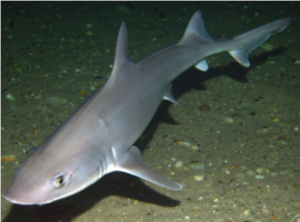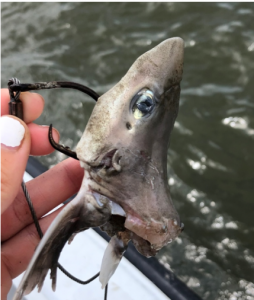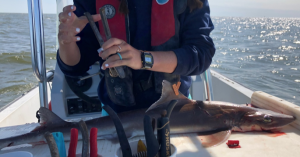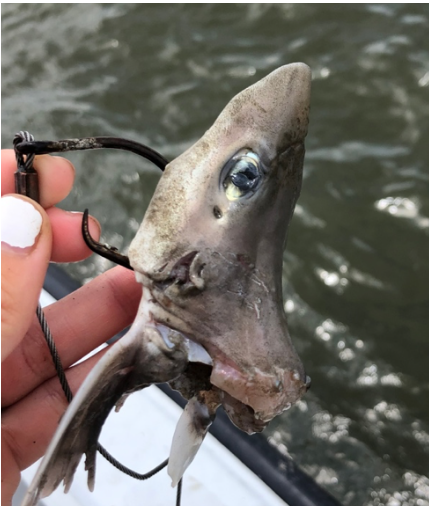Each summer, the University of Rhode Island Graduate School of Oceanography (GSO) hosts undergraduate students from all over the country to participate in oceanographic research. These Summer Undergraduate Research Fellows (SURFOs) have not only been working with GSO scientists, but they have spent part of their time learning how to communicate this science to the public. Read on to find out what they have been up to, and why they everyone should be as excited as they are about their work.
Brianna Villalon is a senior at Texas A&M University-Corpus Christi, studying marine biology and looking to gear her research toward elasmobranchs. This summer she worked with Camilla McCandless at the NOAA Northeastern Fisheries Science Center alongside the Apex Predator Shark Tagging Program. Read on to learn more about her work with dogfish!
— — — — — — —
Background
Smooth dogfish are smaller coastal water sharks that feed at the bottom of the water column. They can be found anywhere from Massachusetts to Florida, however are only found in the North Western Atlantic in the summer because they are drawn to cooler temperatures.

These sharks use both the Delaware and New Jersey bays to reproduce during the summer and move back out to deeper waters when the temperature begins to warm in the bay. Dogfish are important in commercial fisheries and other aspects in our daily society; however, we are seeing a decrease in their presence. We are trying to identify the source of their decline, which could be due to environmental changes, predation, or changes in migration patterns.
The dogfish world
Smooth dogfish have to face a series of dangerous factors in their habitat. The most obvious of these dangers is predation. The more dominant species that are outcompeting smooth dogfish are the sandbar and sand tiger sharks. More predominantly, sandbars are also coastal water sharks that share similar migration patterns with dogfish because they use the Delaware and New Jersey Bay to reproduce as well. These sandbar sharks are born larger, faster, and stronger. Imagine holding a couple of 30-pound sandbags, aka a sandbar’s body structure.

They are firm and full of pure muscle, as opposed to a smooth dogfish that feels somewhat like a common trout, meaning their body is easily flexible and not as sturdy. These smooth dogfish are no match against a sandbar; therefore, dogfish are being outcompeted for similar resources, habitat, and even being fed on as prey by larger sharks. These dogfish also have to face the strains of a changing environment from society’s actions. Ocean temperatures are heating up, affecting dogfish’s migration patterns. We are looking at data to see if dogfish are arriving in the bays earlier or later than usual, as well as when they leave to go back to cooler waters.
Why care about dogfish like you care about your dogs?
Smooth dogfish can benefit society in various aspects. One being the industrial side to things, such as commercial fisheries. Ever think about that seafood you’re picking up at the market? Think about how you would feel when you showed up one day to find nothing on the market. Commercial fisheries and even local organizations provide us with a variety of seafood and also provide employment to thousands of individuals. If dogfish are not studied, we may not know enough about them to sustain a healthy population. With all the endangered and extinct species, let’s not add to the list.
On that note, dogfish are critical for scientific research. Simply said, without dogfish in our waters, there would be no dogfish research. Sounds like no big deal, however, everything in the ocean is tied together. From the plankton to the sharks to the ocean currents. Everything correlates one way or another and with one missing link in the ecosystem, ripple effects are inevitable.

Taking action
The initial goal of studying smooth dogfish is to know enough information about them in order to sustain a healthy and stable population before their decrease is too significant. To do so, we are targeting where fisheries are catching dogfish and recording the amount, they catch to give us
an idea of their current population status and migration patterns. We also sample these fish every month on a yearly basis to see where they are throughout all seasons, relating it to any temperature and salinity shifts. We tag each shark to monitor their distribution and relay it back to environmental changes. With these efforts, we can soon enough determine if smooth dogfish are stable enough to keep fishing for commercial industries.
I love writing of all kinds. As a PhD student at the Graduate School of Oceanography (URI), I use using genetic techniques to study phytoplankton diversity. I am interested in understanding how environmental stressors associated with climate change affect phytoplankton community dynamics and thus, overall ecosystem function. Prior to graduate school, I spent two years as a plankton analyst in the Marine Invasions Lab at the Smithsonian Environmental Research Center (SERC) studying phytoplankton in ballast water of cargo ships and gaining experience with phytoplankton taxonomy and culturing techniques. In my free time I enjoy making my own pottery and hiking in the White Mountains (NH).

